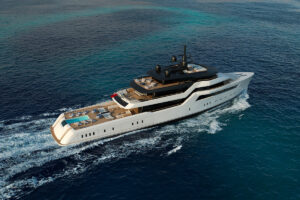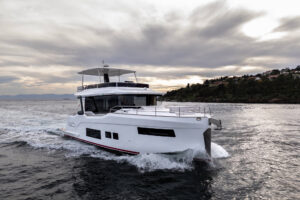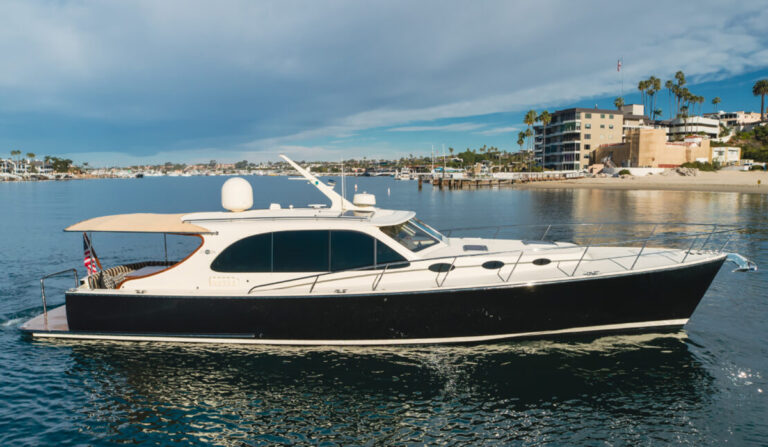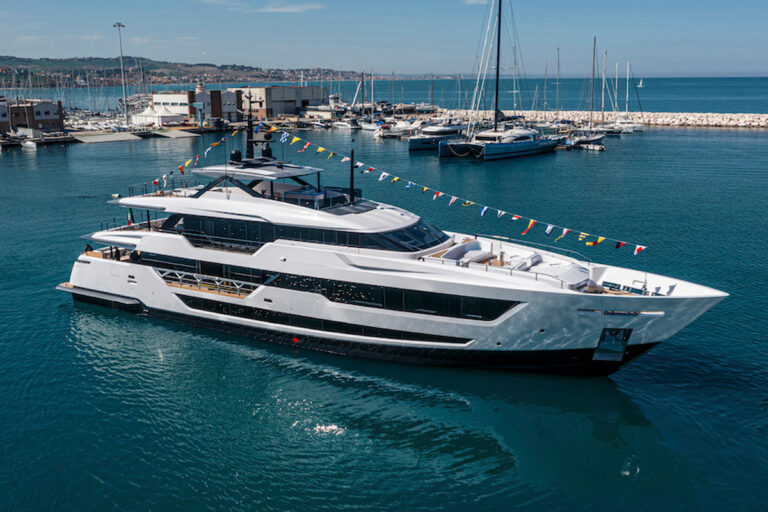
Oyster 82
Sailing in 40-50 knot winds is a pretty severe test for any yacht-the sort of conditions where things break and structures fail. That’s why, when I turned up to review Oyster Marine’s new 82 deck saloon cruising yacht on a day with occasional Force 9 gusts, in truth, I was rather surprised to go sailing at all.
But there were no qualms on the part of the skipper or crew of Bare Necessities, apart from the judicious use of fenders to save the yacht’s brightwork as we left our dock. Even better, none of those who remained within the safe confines of this Oyster’s expansive cockpit got wet as we skated around England’s exposed Solent waters at a speed of 10 to12 knots. Plowing upwind through short, sharp seas at an easy angle, Bare Necessities remained rock steady, making it easy to walk around. The only reminder to the immense stresses came when a staysail sheet snapped with a bang. “Those ropes are designed to take a 10-ton loading, so I guess we must have exceeded that,” was the comment from our representative from Oyster, who immediately offered the owner a free upgrade in sheet size.
It is an accolade to Oyster Marine that half their new builds are repeat orders from existing owners; invariably, the desire is to move up in size. It was this that prompted company founder Richard Matthews and his team to develop this 82-footer, as well as to plan on offering a 100-footer in the future. The first three of these fiberglass Oyster 82s to be launched were sold from plans; a further three are now being built, with two destined for American waters, where the brand has a strong following, particularly in the Caribbean. The British company inspires its faithful flock by organizing hugely popular race weeks in far-flung corners of the world, where the emphasis is on fun and sharing cruising experiences with others in this rather exclusive club. Last year saw 14 yachts compete in the Oyster Rally at Newport, which has a central sales office, and 32 in the Caribbean week in the British Virgin Islands.
Richard Matthews started the business at the tender age of 24; he is an immensely personable yet fiercely competitive character, who has won more than his fair share of prestigious trophies-from the Britannia Cup at Cowes to the SORC series around Florida. He owns and still races the former British America’s Cup 12-meter Crusader, and lives up to his philosophy: “Fast is more fun than slow-even when cruising.” His spirit has rubbed off on many of his owners, whose Oysters have won Antigua Race Week four times and have become the dominant marque in bluewater events like the Atlantic Rally for Cruisers (ARC), the Trade Winds Round the World event and the Europa Around the World Rally. Of the thousand Oysters launched over the past three decades, 125 have completed the ARC race, and 24 have gone on to circle the globe.
One to follow in their wake will be Darling, the second of these Oyster 82s, which is bound to generate considerable mirth during radio chats as she goes around. The third 82 of the line-our review yacht-was built for charter in the UK, where she commands around $7,000 a day. Outwardly, the two yachts are very similar, with the latest carbon rigs, but belowdecks the variations show the extent that these custom-built yachts can be tailored to meet the requirements of their owners.
One feature both share is the high-level deck saloon configuration first pioneered by Oyster back in 1978, which remains a hallmark of their cruising range. In terms of aesthetics, the bigger the yacht, the more pleasing the angular outboard profile becomes, to the point where the lines blend almost seamlessly into the deck line on this 82. The advantages become apparent the moment you step below, for the concept creates an especially light and airy living area with fantastic visibility from within the large split-level saloon. The other major practical consideration that the raised floor offers is plenty of space in the engineroom, which allows for other heavy items like tankage and batteries to be situated close to the yacht’s center of gravity, which dampens pitch and rolling in heavy seas.
Even better, the raised deck and the glass windshield (fitted as an extra on this yacht) protect the cockpit against any spray. In more clement conditions, the large windows can be opened outward to greatly improve fair-weather ventilation. (Though air-conditioning is standard with five compressor units dotted around the yacht.)
The cockpit is split between a separate helm/crew working area and a 10-foot-long central guest cockpit adjacent to the companionway, which is both comfortable and well protected. I particularly liked the neat way that the tail ends of sheets and other ropes are stowed away in pillar-box slit lockers around the sides of the cockpit to save them from getting underfoot. The twin steering wheel configuration was also good, offering excellent visibility all around, though the angle of the flat-screen instrument panels needs to be raised forward to provide an optimum viewing angle and to save the helmsman from craning over the wheel.
The owner of Bare Necessities is-understatement alert!-something of a computer buff. Not surprisingly, flat touch screens adorn every part of the yacht, monitoring everything from course to compass heading. There is even a bevy of screens (with the touch facility disabled) across the companionway to keep guests informed of the yacht’s position on an electronic chart, wind and performance figures, as well as a bird’s-eye view of themselves from a camera at the masthead. From any of the 20 touch screens that can be found in the cabins and engineroom, crew and their guests can switch between a large library of films and music albums, and can monitor anything from engine revs and temperatures, fuel, water and food stocks, to rig sensors, electronic charts and sailing instruments. The three infrared cameras within the engineroom can be angled remotely to check for any irregularities. Sensibly, one of these can be clamped to any part of the engineroom to monitor any aspect of the yacht’s mechanicals from a dripping hose to other parts that may be prone to overheating.
This owner, who also has a smaller Jeaneau 42 that is controlled completely by computers, designed and developed all the computer systems on board. I think he should ring Hollywood and arrange for a very rugged reality show to be filmed, calledÉBare Necessities.
Belowdecks, every inch of this Oyster 82 radiates luxury. The maple interior furniture provides a light and airy feel to the boat, though other woods like teak, American white oak and cherry are also offered. This is really where semi-custom building comes into its own, for owners not only have a choice of finishes but layout options that will depend on whether the yacht is to be marina based, sailed with a small professional crew, or handled by an experienced coterie of family and friends. Other factors might depend on whether the yacht is to be used primarily for coastal or bluewater cruising in cold or hot climates, and whether it will be geared towards weekend use or live-aboarding in deep or shallow cruising grounds.
Almost anything is possible within the constraints of the seven watertight bulkheads. This owner had day charters for up to 18 guests (and four crew) very much in mind when it came to the interior design of his 82. But he still got his 18-foot-wide master stateroom aft with private access to the aft deck. And there are two twin-bedded guest cabins, all with en suite facilities. The crew is quartered in two separate cabins forward of the mast.
Between crew and guest quarters is an enormous main saloon, which includes a 10-seat circular dining area on one level, offering panoramic views through the expansive glass area afforded by the raised deck. A second dining/lounge area on a lower level seats a further 10. The yacht’s navigation and communications center is on the starboard side of the upper level, within two strides of the companionway.
Opposite the lower saloon area is an impressive open-style galley with a large induction burner and oven, fridge, freezer and dishwasher, together with a large pantry. The washer/dryer is fitted into the bow area, together with occasional fold-down pipe cots. On Darling, which is built for world cruising, a day head replaces the galley area, which in turn is situated in an enclosed area on the port side forward of the mast. A third twin-bunk guest cabin with shared facilities replaces the skipper’s cabin on Bare Necessities; instead, Darling’s crew share a twin V-berthed cabin forward.
Both yachts are equipped with Hood carbon spars. Darling’s mainsail furled up inside the mast, but on Bare Necessities, which is equipped with Doyle Cuban-fiber performance sails, the fully battened sail drops down onto an 850-millimeter-wide Park Avenue Boom. The genoa and staysails are furled on their headstays, which operate hydraulically.
With all winches push-button operated, the sailing side of this Oyster can be handled by as few as three crew. In the strong winds we faced, she handled supremely well, though the steering downwind would soon tire an inexperienced hand. But then, that is what the autopilot is for. She was also easy to maneuver under power; with the aid of her 30 hp retractable Lewmar bowthruster, all was simple to control from the port wheel position.
Our thrilling day ended with a final test, when we had to reverse Bare Necessities back into a very tight marina berth when the anemometer was still showing 40 knots of side wind. Would she be carried away? Our first effort wasn’t quite right, and by the time she was lined up, the wind had control of the bow. We pulled out, turned the boat round in her own length and had another go, and this time she went in perfectly. “There are no prizes here for hitting anything-and no pride lost in having another go,” said our affable skipper. To my mind, he did brilliantly to do it in two. If it had been my boat in those conditions we might still be there trying vainly to coax her in.
Contact: Oyster Marine USA, (401) 846-7400; info@oysteryachts.com; www.oystermarine.com.









